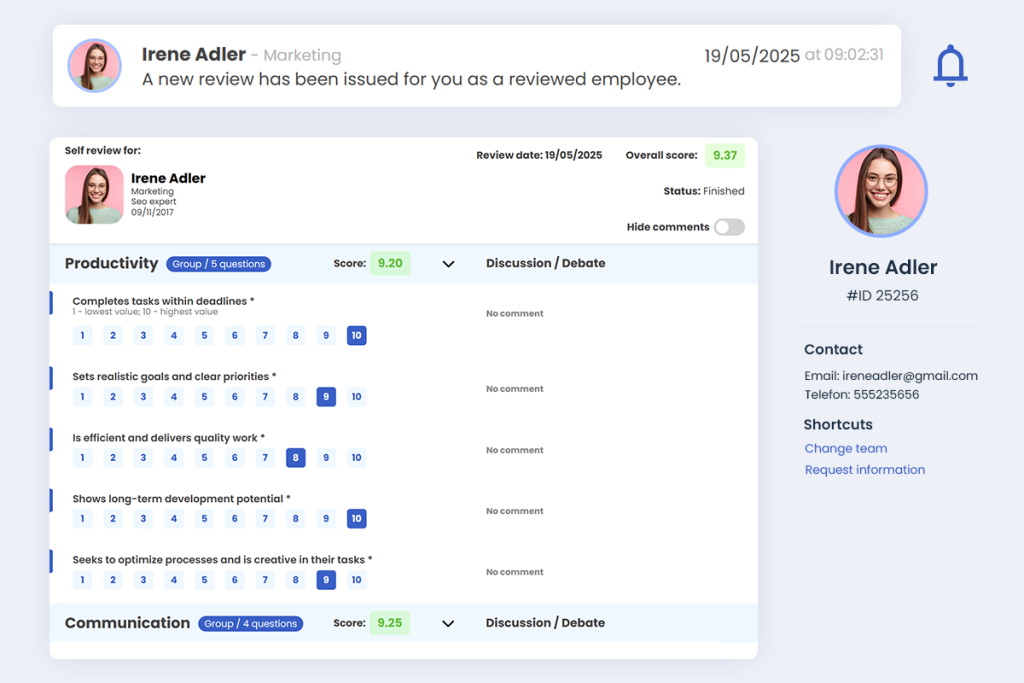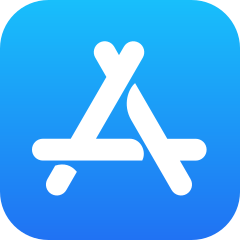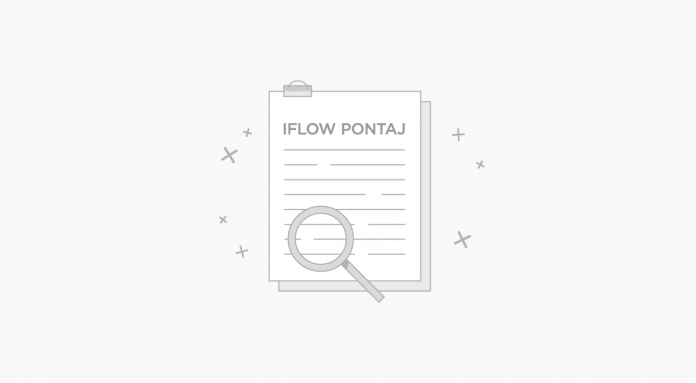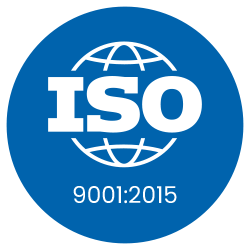Self evaluation is a powerful tool for personal growth and organizational development. In this article, you’ll learn what it involves involves, its benefits, the most effective formats, and how to integrate it into your performance review process.
We’ve also included a free self evaluation template you can download and customize to suit your team.
What is employee self evaluation?
Self evaluation allows employees to reflect on their performance over a defined period. Through a digital or written form, employees assess their accomplishments, challenges, and development needs, and set future goals.
For managers, self evaluation at work provides context that might otherwise be missed, especially in large teams. For employees, it offers visibility, voice, and empowerment.
The benefits of self evaluation for employees and employers
Benefits for employers
Self evaluation provides visibility into employee performance directly from the source. It simplifies the review process and makes manager-employee conversations more productive and focused.
It also helps identify early warning signs such as overwork, disengagement, training needs, or potential for promotion.
Besides that, it is a key step in fostering a workplace culture centered on feedback and continuous learning.
Benefits for employees
For employees, self evaluation is an opportunity for reflection. It helps them recognize their strengths, understand what worked well, and identify where support is needed.
It also increases a sense of ownership and autonomy. Employees are encouraged to take responsibility for their own development.
Moreover, it is a chance for them to highlight achievements that might otherwise go unnoticed in daily operations.
Types of self evaluation
Written self evaluation (paper-based)
This traditional method involves manually completing a form with questions about goals achieved, accomplishments, challenges, and development needs. It can be adapted based on the employee’s role or team.
Due to the digitalization of HR processes, this type of evaluation is becoming less common, being replaced by faster, more accurate, and easier-to-manage digital solutions.
However, it is still used in small teams or in organizations without digital infrastructure, where the process remains simplified. In such cases, the written self evaluation is often followed by a direct discussion with the manager to clarify and complement the performance perspective.
Digital self evaluation (platforms, apps)
Digital self evaluation involves using a specialized app to complete, submit, and store evaluations directly in the company’s information system. Compared to the written method, it allows for better standardization, customization, and automated distribution of forms tailored to each department or role.
One such solution is HR iFlow, a complete digital HR and time tracking platform that includes a dedicated module for employee review (iPR by HR iFlow). The application helps companies manage the entire evaluation process: from form creation, automatic scheduling of feedback rounds, and collecting responses, to generating reports and accessing individual performance history.
Advantages of self evaluation with HR iFlow:
- Customizable evaluation templates and evaluation forms: Create tailored templates for each department or role
- Scheduled evaluations (quarterly, annually, etc.): Set deadlines and send automated notifications
- Integrated 360° feedback: Gather input from colleagues, subordinates, and supervisors
- Evaluation history & traceability: Quick access to each employee’s history (past self evaluations, comparisons) and tracking progress
- Role-based access (employee, manager, HR): Each user accesses only relevant sections
- Centralized data & reports: Easily generate reports for company-wide or departmental performance insights
While digitalization may initially seem impersonal, it actually provides a clear and effective framework for initiating real, meaningful discussions between employees and managers. A self evaluation completed through the platform becomes a strong starting point for a constructive dialogue focused on results, growth, and professional development.

Want to try HR iFlow? Create a free account or schedule an online demo to see how easily you can implement digital self evaluation in your organization!
Guided self evaluation (one-on-one discussion)
This type of evaluation involves a direct conversation between the employee and a manager or team/department leader. It can take place in a structured or informal setting, either in person or online. The employee has the opportunity to share their perspective, justify accomplishments, and openly discuss challenges faced.
This format is often used as a complementary step to written or digital self evaluation, helping to clarify responses and provide additional context where needed. The discussion can uncover opportunities (e.g. outstanding performance that could lead to promotion) or highlight issues (e.g. workload imbalance that may require resource reallocation).
To make the most of this form of evaluation, it is recommended to:
- Conduct it after a written or digital self evaluation, to provide a structured starting point
- Ensure a trust-based, collaborative environment, as its effectiveness greatly depends on the quality of the relationship between the employee and the manager or team leader
- Document key takeaways from the discussion to avoid omissions and ensure traceability

Our recommendation
For an effective, clear, and balanced evaluation process, we recommend combining the advantages of digital tools with the benefits of direct human interaction.
More specifically:
- Use a dedicated evaluation software like HR iFlow to standardize and centralize evaluations. This enables fast data collection, performance history tracking, and objective analysis.
- After analyzing the results, schedule one-on-one discussions with employees to clarify responses, identify development opportunities, and address any concerns.
This hybrid approach supports both transparency and authentic human relationships, which are essential for a healthy, growth-oriented organizational culture.
How often should self evaluation be conducted?
There’s no universal standard for how often self evaluation at work should take place. It largely depends on your company’s goals, pace, and organizational culture.
HR experts generally recommend the following:
- Quarterly: Ideal for fast-paced companies where goals change frequently. This allows for quick feedback and real-time course correction.
- Biannually: Suitable for stable organizations with moderate change. It provides a good balance between feedback and progress tracking.
- Annually: Works well as a year-end review, but may be insufficient on its own without more frequent check-ins or feedback rounds.
In many organizations, a formal performance review is conducted once a year, but it’s often supported by more regular self evaluation and feedback sessions (quarterly or biannually). This blended approach helps ensure employees stay aligned with company objectives and feel consistently supported in their development.

For companies: How to successfully implement a self evaluation strategy
Involve managers in the process
Don’t leave everything to HR. Train managers to treat evaluations as conversation starters, not just documents. They should understand how to interpret the feedback and turn it into actionable development plans.
Ensure transparency and clear communication
Communicate the evaluation timeline in advance, explain the objectives, and clarify how the responses will be used. Lack of clarity can result in incomplete responses or employee distrust in the process.
Test and refine before scaling
Run a pilot program in one department before a full-scale rollout. Gather feedback on the questionnaire, timing, and clarity of questions to improve the process.
Integrate self evaluation into development plans
A professional self evaluation should go beyond a form. Use the insights to shape training, coaching, or promotion pathways. Otherwise, employees may view the process as a meaningless formality.

For employees: How to present your achievements in a self evaluation
A self evaluation is your chance to tell your professional story beyond the numbers. When approached thoughtfully, it can positively shape how others perceive your contributions and open doors to promotions, training, or new projects.
Here are some tips to keep in mind:
Be specific
Use clear, concrete examples. Instead of saying “I had good results,” write “I reduced ticket resolution time by 25%.”
Show impact
Connect your actions to outcomes. How did you contribute to your team’s or company’s goals?
Mention challenges you overcame
Explain how you navigated difficult situations. This demonstrates initiative and adaptability.
Acknowledge areas for improvement
An honest self evaluation includes development points. It shows self-awareness and a willingness to grow.
Set clear goals
Outline your focus for the coming period: What do you want to learn? What results are you aiming for? Where do you need support?
Free self evaluation template
We’ve created a free self evaluation template that is easy to use and customize. You can download and share it digitally for completion, or integrate it into platforms like HR iFlow, adapting it to each team or department’s specific needs and objectives.
Download the free self evaluation template now and turn your feedback into a powerful tool for progress.







